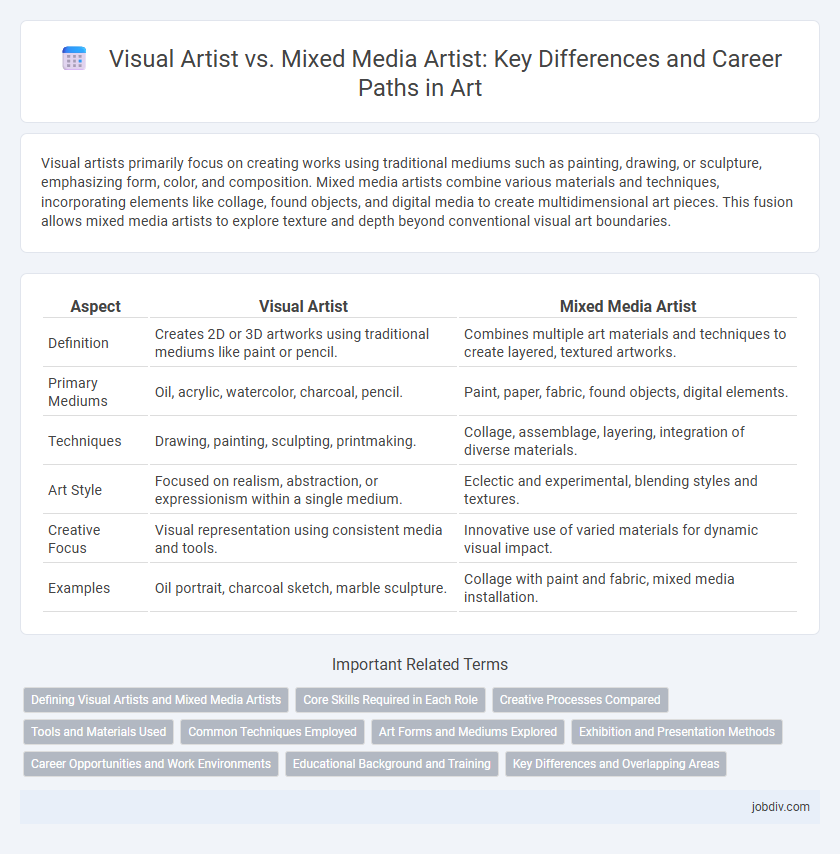Visual artists primarily focus on creating works using traditional mediums such as painting, drawing, or sculpture, emphasizing form, color, and composition. Mixed media artists combine various materials and techniques, incorporating elements like collage, found objects, and digital media to create multidimensional art pieces. This fusion allows mixed media artists to explore texture and depth beyond conventional visual art boundaries.
Table of Comparison
| Aspect | Visual Artist | Mixed Media Artist |
|---|---|---|
| Definition | Creates 2D or 3D artworks using traditional mediums like paint or pencil. | Combines multiple art materials and techniques to create layered, textured artworks. |
| Primary Mediums | Oil, acrylic, watercolor, charcoal, pencil. | Paint, paper, fabric, found objects, digital elements. |
| Techniques | Drawing, painting, sculpting, printmaking. | Collage, assemblage, layering, integration of diverse materials. |
| Art Style | Focused on realism, abstraction, or expressionism within a single medium. | Eclectic and experimental, blending styles and textures. |
| Creative Focus | Visual representation using consistent media and tools. | Innovative use of varied materials for dynamic visual impact. |
| Examples | Oil portrait, charcoal sketch, marble sculpture. | Collage with paint and fabric, mixed media installation. |
Defining Visual Artists and Mixed Media Artists
Visual artists create works using traditional mediums like painting, drawing, and sculpture, focusing on form, color, and composition to convey artistic expression. Mixed media artists combine several art materials, such as paint, fabric, paper, and digital elements, to produce multidimensional and textured artworks. The distinction lies in the mixed media artist's emphasis on blending diverse materials to achieve innovative visual effects beyond singular medium constraints.
Core Skills Required in Each Role
Visual artists require strong drawing, painting, and composition skills to create traditional two-dimensional artworks emphasizing color theory and perspective. Mixed media artists need versatility in various materials and techniques, combining painting, sculpture, collage, and digital elements to produce multidimensional pieces. Both roles demand creativity, attention to detail, and an understanding of artistic principles, but mixed media artists must excel in material experimentation and integration.
Creative Processes Compared
Visual artists often specialize in specific mediums such as painting, drawing, or sculpture, emphasizing mastery and detailed exploration of their chosen materials. Mixed media artists integrate diverse materials and techniques, fostering innovation through layering, collage, and multimedia elements that challenge traditional boundaries. The creative process of mixed media artists involves experimental combinations and adaptability, while visual artists typically follow a more focused, medium-specific approach to composition and execution.
Tools and Materials Used
Visual artists primarily use traditional tools such as pencils, brushes, canvas, and paint to create works focused on form and color. Mixed media artists combine diverse materials including paper, fabric, found objects, and digital elements, integrating these to build layered and textured compositions. The choice of tools and materials significantly influences the tactile quality and dimensionality of the art produced.
Common Techniques Employed
Visual artists commonly employ techniques such as drawing, painting, and sculpting, using traditional materials like canvas, paper, clay, and charcoal to create focused, medium-specific works. Mixed media artists integrate a variety of materials and techniques, combining painting, collage, digital elements, and found objects to produce layered, multidimensional artworks. Both approaches emphasize creativity and expression, but mixed media frequently involves experimental processes and unconventional mediums to expand visual storytelling.
Art Forms and Mediums Explored
Visual artists primarily engage with traditional mediums such as painting, drawing, and sculpture, focusing on visual aesthetics and techniques to express concepts and emotions. Mixed media artists combine diverse materials like paper, fabric, found objects, and digital elements, creating multidimensional artworks that transcend singular art forms. This fusion of mediums allows mixed media artists to experiment with texture, depth, and narrative complexity, offering a more eclectic and innovative artistic expression compared to conventional visual art.
Exhibition and Presentation Methods
Visual artists often emphasize traditional exhibition methods such as gallery showings, solo exhibitions, and curated art fairs, showcasing paintings, drawings, or sculptures with focused visual impact. Mixed media artists incorporate diverse materials and techniques, leveraging immersive installations, interactive displays, and multimedia presentations to engage audiences in multisensory experiences. Both adapt their presentation methods to enhance audience interaction, yet mixed media artists generally explore innovative formats beyond conventional gallery spaces to highlight the complexity of their work.
Career Opportunities and Work Environments
Visual artists often find career opportunities in galleries, museums, and commercial art studios, primarily working with traditional mediums like painting and drawing, while mixed media artists have broader prospects in experimental art spaces, multimedia projects, and interdisciplinary collaborations. Mixed media artists frequently engage in environments that encourage innovation and integration of various materials and techniques, making their work highly adaptable to contemporary art trends and digital platforms. Employers value mixed media artists for their versatility in combining textures, digital elements, and physical materials, expanding possibilities in advertising, film, and installation art sectors.
Educational Background and Training
Visual Artists often receive formal education in fine arts programs, focusing on traditional techniques such as drawing, painting, and sculpture, emphasizing foundational skills and art history knowledge. Mixed Media Artists typically pursue interdisciplinary training combining various mediums like collage, digital art, and installation, requiring specialized workshops or courses in diverse materials and experimental approaches. Both paths benefit from hands-on experience and continuous skill development tailored to their unique artistic practices.
Key Differences and Overlapping Areas
Visual artists typically specialize in traditional mediums such as painting, drawing, and sculpture, emphasizing visual composition and aesthetics. Mixed media artists blend various materials and techniques, integrating non-traditional elements like fabric, paper, and found objects to create multidimensional works. Both disciplines overlap in their focus on visual expression and can employ layering, texture, and form to convey conceptual narratives or abstract ideas.
Visual Artist vs Mixed Media Artist Infographic

 jobdiv.com
jobdiv.com